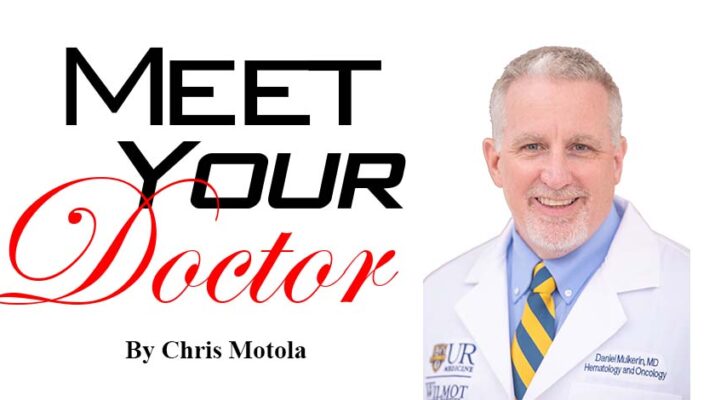By Chris Motola
Head of Wilmot Cancer Institute in Webster explains why UR Medicine built a large cancer center in eastern Monroe County
Q: Can you describe your role at the new cancer center in Webster?
A: The new center in Webster is one of 15 regional locations for the Wilmot Cancer program. It is the newest and one of the largest. I’m responsible both for seeing patients directly myself and also placing new services into the center.
Q: What does this offer relative to the main site?
A: There’s a wide range of services. Our center is large enough that we have medical cancer specialists, surgical cancer specialists and capacity for radiation oncology and a linear accelerator on site. We have an infusion center, which allows us to give chemotherapy on site. We’re able to draw and administer blood onsite. I have physician specialists who focus on things like gastrointestinal cancer care, breast cancer care, urinary cancer care, chest surgery, colorectal surgery and others. The facility is physically designed very well to deliver multidisciplinary care. The surgeons, medical and radiation doctors can all see the patients physically on the same day, at the same location and deliver a team plan for care.
Q: As associate director, are you the head of the site?
A: Yes, I’m an associate director, which means I report directly to Dr. Jonathan Friedburg, who is the overall director for the Wilmot Cancer Institute. There are a variety of folks with other responsibilities, but within our regional operations at locations that go as far west as Batavia, as far east as Geneva and as far south as Elmira, we have a variety of operations, and caring for and growing the program in those locations is my responsibility.
Q: Why was Webster selected as a site?
A: That’s great question. When we look at the demographics, Webster is the largest of what we’d call the suburbs of Rochester, with more than 50,000 people. This population has a significant cancer burden, in part due to our high rates of smoking in Upstate New York and other factors. So it’s both the size and the smoking-related illnesses. It’s also an area that’s relatively underserved when it comes to making care convenient for people at home. Even the 25-minute commute into Rochester and dealing with parking on campus could create issues. So we wanted to be able to provide quality care to Webster and communities to its east. As far as why smoking rates are so high in Upstate New York, I don’t really have an answer for that. There’s a lot of effort put into research into smoking cessation. I think there are correlations across our whole society regarding socioeconomic status and challenges in less financially well-off populations. That part is pretty well established.
Q: Beyond smoking, what are some of the issues creating high rates of cancer in Webster?
A: Aside from the size of the population, it’s the aging of the population that mainly drives cancer rates.
Q: How long have you been open?
A: [At time of interview] We just opened two weeks ago. I would say the patients and the providers are really enjoying being able to be seen in or service in a brand-new facility close to home. [Patients] are able to receive almost all the care that they can receive on the main campus close to them. It’s a state-of-the-art facility providing a variety of care in location that minimizes the disruption to their lives while they face cancer.
Q: Of the Webster area patients that had been going to Wilmot, what percentage do you think the Webster site has captured so far?
A: I can only speak for the University of Rochester patients, not people who receive care through the Rochester Regional or similar programs. I think up to 10% or more of our main campus will be eligible. And that includes people who are on the east side of the bay. That includes Webster, Ontario, Penfield, all with convenient access to our Webster location. So it will end up being a sizable percentage of our total patient population.
Q: What made you interested in this position?
A: Prior to moving to Rochester, I had been doing similar work for the University of Wisconsin in Madison. For me, I think it’s about the passion of trying to bring the very best of what large cancer centers have to offer into community settings. Because for our patients facing cancer; being able to receive care close to home is important. It allows the patient to have a support network. It minimizes hassles during a very difficult time in their lives. We think programs like this allow us to bring the very best of a large university cancer center into a community setting.
Q: How far do you think this concept of university center-quality care in community settings can be stretched? How small can the community be? Or how wide a footprint can it draw in? What’s the ideal community for a satellite cancer center?
A: I do think the potential size of the population dictates the size and scope of the program. It does take a critical number of individuals. A site that draws from, say, a population of less than 15,000 people, we’re not able to deploy the full technology and a full-time practice in a way that’s financially responsible for the community. But for any community that has more than 15,000 or 20,000 people, that’s enough to deliver full scale cancer care in a community setting.
Lifelines
Name: Daniel Mulkerin, M.D
Position: Associate director, Regional Operations for Wilmot Cancer Center
Hometown: Walla Walla, Washington
Education: Jefferson Medical College, Thomas Jefferson University
Affiliations: Strong Memorial Hospital; Highland Hospital
Organizations: American Society of Clinical Oncology; Empire State Hematology Oncology Society
Family: Wife (Mary, an oncology nurse), four adult children
Hobbies: Swimming, going to national parks

